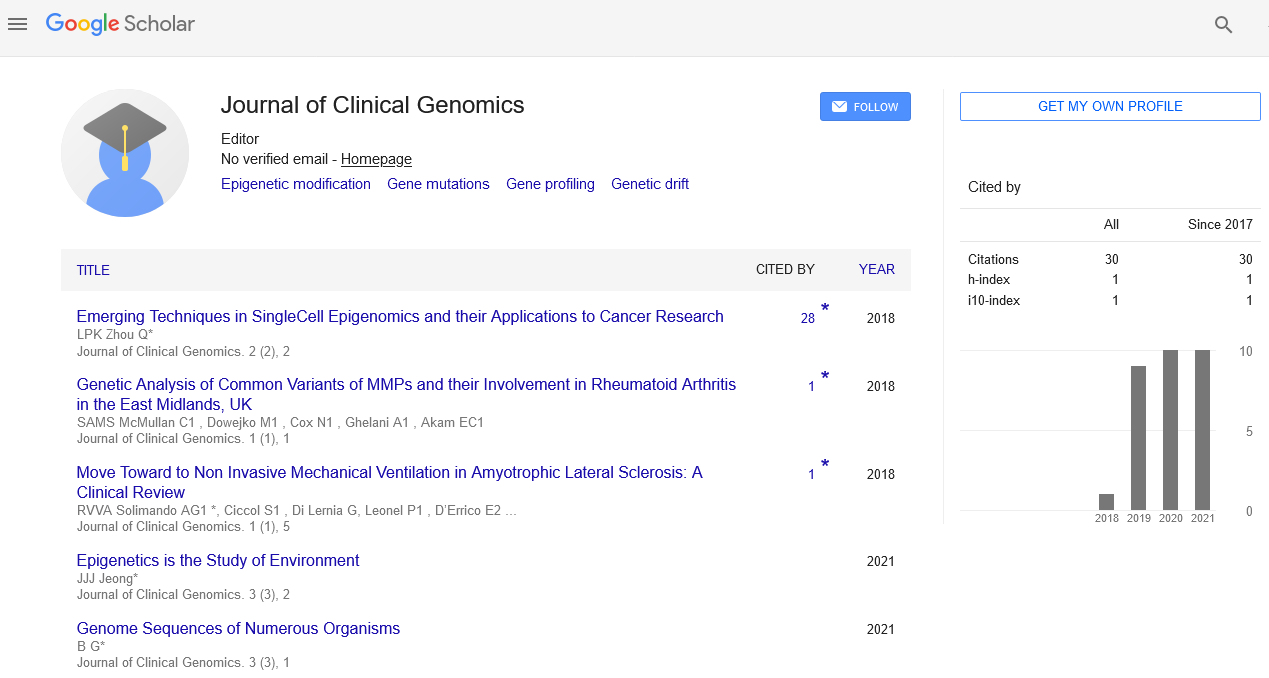Commentary, J Clin Genom Vol: 3 Issue: 5
Assessment of Genetic Drift in Large Pharmacogenomic Studies
Jennifer Ovenden*
University of Toronto, Department of Medical Biophysics, Toronto, Canada
- Corresponding Author:
- Jennifer Ovenden
University of Toronto, Department of Medical Biophysics, Toronto, Canada
Tel: +15282643746;
E-mail:Ovenden29@gmail.com
Received date: 07 December, 2021; Accepted date: 22 December, 2021; Published date: 30 December, 2021
Keywords: Gene mutations, Gene profiling, Genetic drift , Genetic Mutation
Descrption
Inheritable drift is a medium of elaboration in which allele frequentness of a population change over generations due to chance. Inheritable drift occurs in all populations’ of non-infinite size, but its goods are strongest in small populations. Inheritable drift may affect in the loss of some alleles and the obsession, or rise to 100 00, percent frequency, of other alleles. Inheritable drift can have major goods when a population is sprucely reduced in size by a natural disaster or when a small group splits off from the main population to plant a colony. Natural selection is an important medium of elaboration. But is it the only medium fact, occasionally elaboration just happens by chance. In population genetics, elaboration is defined as a change in the frequency of alleles in a population over time. So, elaboration is any shift in allele frequentness in a population over generations whether that shift is due to natural selection or some other evolutionary medium, and whether that shift makes the population more suited for its terrain or not. In this composition, we’ll examine inheritable drift, an evolutionary medium that produces arbitrary changes in allele frequentness in a population over time.
Genetic Drift
Genetic drift is change in allele frequencies in a population from generation to inheritable drift is change in allele frequentness in a population from generation to generation that occurs due to chance events. To be more exact, inheritable drift is change due to slice error in opting the alleles for the coming generation from the gene pool of the current generation. Although inheritable drift happens in populations of all sizes, its goods tend to be stronger in small populations. In our illustration, the allele frequentness of the five lucky rabbits is impeccably represented in the alternate generation, as shown at right. Because the rabbit sample in the former generation had different allele frequentness than the population as a whole, frequentness of B and b in the population have shifted to 0.70, point, 7 and 0.30, point, 3, independently. From this alternate generation, what if only two of the BB seed survive and reproduce to yield the third generation. In this series of events, by the third generation, the b allele is fully lost from the population.
The Founder Effect
The founder effect is another extreme illustration of drift, one that occurs when a small group of individualities breaks off from a larger population to establish a colony. The new colony is insulated from the original population, and the founding individualities may not represent the full inheritable diversity of the original population. That is, alleles in the launching population may be present at different frequentness than in the original population, and some alleles may be missing altogether. The author effect is analogous in conception to the tailback effect, but it occurs via a different medium. Random groups that depart to establish new colonies are likely to contain different frequentness of places and circles than the original population. So, the allele frequentness in the colonies may be different relative to the original population. Also, the small size of the new colonies means they will witness strong inheritable drift for generations. The author effect and the tailback effect are cases in which a small population is formed from a larger population. These “tried” populations frequently don't represent the inheritable diversity of the original population, and their small size means they may witness strong drift for generations.
 Spanish
Spanish  Chinese
Chinese  Russian
Russian  German
German  French
French  Japanese
Japanese  Portuguese
Portuguese  Hindi
Hindi 